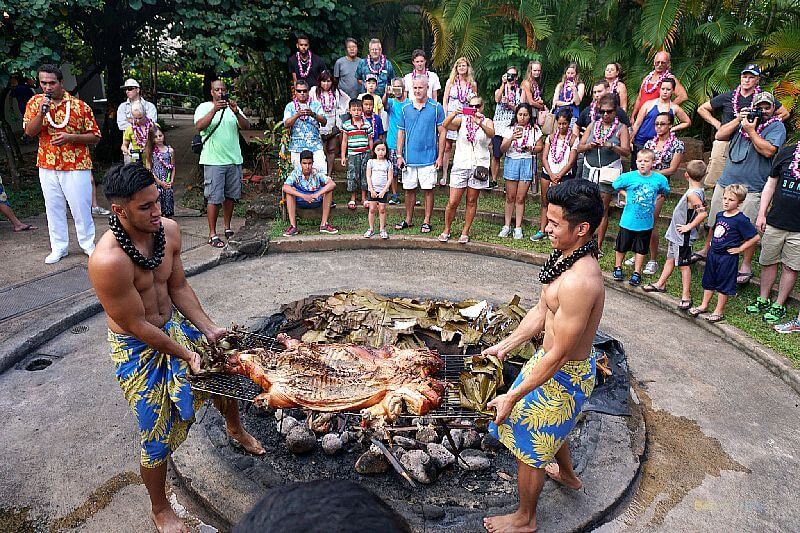Pipe Lines of Kaimu: Imu Ground Oven
Become a
Premium Member
and post notes and photos about your poem like Hilo Poet.
Poetic Form: Narrative
Inspired: 2023 November 27
Image: Swimmer Slicing the Curl by Private Photo


Preparations for 'Luau' (LOU-ow) or a Hawaiian Party-like event, for a church Luau, would be a 'Ho'ike' (hoe-'E-kay). The hunters will tie the hind legs of whatever animal will go into an 'i'mu' (E'-moo), which is a dugout hole in the dirt ground, and small amounts of sand thrown in to tame the dirt to be more stable and workable when they're padded down and around the open pit. Chopped wood from the neighboring O'hia (oh-HE-ya) forested trees (NOTE: I've written a short story of the Kalapana version of the Ohia tree and its blossoming Lehua (lay-WHO-wah) flower Legend. As the animals are being prepared for the imu, the process of that is done well in advance for the reason that follows.
The imu process takes a bit of time to set up--usually, imu's preexist at most Hawaiian home yards. At least one, and sometimes more than one may exist--The Kalapana church has two imu's side-by-side, well, just a little ways apart, under an iron-like roofing. The cut wood will be stacked like a mountain, having a wider bottom as it thins out going up. Fortunately, church members usually bring at least a cord of cut wood and leave it stacked around the imu shed of the church. The excess cut wood will be stacked alongside our church hall. Lava stones, or igneous rocks, and some basaltic rocks, both have heat-retainable properties. These rocks are piled atop the cut wood pile, rather sparsely or spread out where air would maintain the fire and not snuff out the ongoing fire. Kerosene or other forms of igniters that'll quicken and further stretch the fire, is poured generously over the lava-rock-covered wood pile.
The animals with their hind legs tied up, whether their pigs, goats, and sometimes, cows, are then hoisted upwards. Now pigs don't have much hair like the goat or cow. Their hair is very fine and hardly noticeable. They're removed with this apparatus that you slide over the animal, after pouring very hot water which causes the pig hair to stand outwardly for an easier removal process. They are then cut open from the rear where their hind legs were tied up to hold them up during the processing of them for the imu, which has long started. Their innards are yanked out and then placed into a large wide metal container for other forms of cooking that's done in the kitchen. The imu takes about three and some hours long.
The near-time events are when the animal/s is placed on the chicken wire then they are laid on their backside and the legs are spread open and held open, several people are needed to perform this action--carrying whatever type of animal requires some people. The Luau processing is a family affair if it's a private luau event, being that it is a Ho'ike, then it's a church member galore hands-on affair. Now while the animal on the chicken wire is held open, Hawaiian salt called Alaea (A-lay-a), is rubbed inside the animal. The imu pit would have been ready before this part of the luau process. The burning woodpile will eventually collapse and fall downward into the pit, and in effect, it'll bring down the now hot rocks into the pit as well, with the help of some long metal clip holders, these meddlers will spread the hot rocks into a pit-like formation that will indicate its receptive of the animal.
The salted animal, legs are carefully held open and kept opened as a few hot rocks are placed inside the animal, and depending on its size, will determine the number of hot rocks that will go inside the animal. Then before the chicken wire gets tied up, other smaller stuff will go in along with that animal or other chicken wires will be required, hence the reason for having more than one imu. Other stuff such as turkeys, chickens, rabbits, piglets, and sometimes, Kulolo, which is a Hawaiian coconut pudding that gets a bit hard in the imu processing. Lastly, the chicken wires get tied which snugs up the animals, if the case may be. Sometimes smaller luaus would not have been so gargantuan to have been so, as it would be in the case of a Ho'ike. IMPORTANT to note: nothing from the sea goes into an imu, except the Alaea salt which is a sea salt.
The chicken-wired animal/s are placed in the pit, the hot rocks are piled all around and atop, basically, those chicken wired animals become unviewable. Then banana stumps/barks are bashed open, pulled apart, and spread over the area, whole ti-leave tops are snapped off and they're spread out over the banana shredded stump, then lastly, dirt is shoveled atop the spread-out flora, that disappears leaving the imu looking like a mound--no smoke must appear oozing out from said dirt pile. Shovels are then placed atop, depending on the weather, either the dirt pile itself, or, atop tarp sheets that cover the non-smoking dirt pile. Needless to say, dig it out, place them in large, medium, or what have you containers that go in the back of people's vehicles. Set the larger containers atop long self-serving tables for the awaiting, well-dressed, churchgoers and sinners alike. All are welcome, as the pastor would say--well not the sinner part, a bit of an inference, methinks.
Copyright © Hilo Poet | Year Posted 2023
Post Comments
Poetrysoup is an environment of encouragement and growth so only provide specific positive comments that indicate what you appreciate about the poem. Negative comments will result your account being banned.
Please
Login
to post a comment